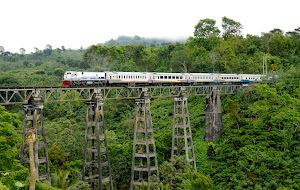Exploring Jeju-Do: Hallasan
1.
HALLASAN (
MT.
HALLA)
Hallasan stands
out at the center of South Korea's southernmost island, boasting exquisite
landscapes due to its varied volcanic topography and vegetation distribution
ranging vertically through the subtropical, temperate, frigid and alpine
zones.The special nature of this area led to its being designated and managed
as a national park in 1970, a UNESCO Biosphere Reserve in 2002, a World Natural
Heritage Site in 2007.
At 1,950m (6,398
ft.), Hallasan is the highest peak in South Korea. This now-dormant volcano
(which erupted during the fourth Cenozoic Era) sits at the center of the island
and can be seen from anywhere on Jeju-do—unless, of course, it’s hiding behind
the clouds, which happens often. Locals say that like a woman, the mountain is
constantly hiding her face. The mountain also changes with the seasons, putting
on bright pink azaleas in the spring and a beautiful white coat of snow in the
winter. The crater at the summit is now a lake, Baengnokdam (which is also the
old name for Hallasan), though the area directly surrounding the lake is
currently closed to give the natural setting time to recover from all the
climbers who’ve visited in the past few years. The name Baengnokdam came from
the legend that the gods came down from the heavens to ride their white deer
(baengnok) on the mountain.
There are four
trails leading up to the top of the mountain, each varying in difficulty and
length. None of them is easy, and you should set aside a whole day if you wish
to reach the summit. Although there is natural spring water available on the
way up, I highly recommend packing some extra water and a meal to enjoy once
you get there. In cooler weather, bring a windbreaker since it will get colder
and windier as you climb higher. The Yeongsil Trail is the easiest, but it
still will take just under 4 hours to reach the top (and another 3 down). You
can take an intercity bus to the Hallasan National Park management office to
pick up the trail head—it starts at the southwestern side of the peak and is
6.5 km (4 miles) long. Personally, I think the Eorimok Trail is the most scenic
(especially in May when the azaleas are in bloom). The entrance is 15 km (9 1⁄3
miles) from Jeju-si and takes about 40 minutes via intercity bus. It’s
7.8km (4.8 miles) long and will take you a little longer than the Yeongsil
Trail. If you want a real challenge, take the Gwaneumsa Trail, which is steeper
than the others. The entrance to the trail is at the Tamna Education Institute,
about 11km (6 3⁄4 miles) from Jeju-si. From there it’s
about an hour to Gwaneum Temple, a total of 3 hours to reach the peak and
another 21⁄2 down. The Seongpanak Trail is an easier
climb with several resting spots. Another great trail for enjoying the azaleas,
it takes about 41⁄2 hours to climb and another 4 to
return. Open all year-round, the park will be closed only for inclement
weather. The park is open 5am to 10pm in the summer and 6am to 9pm in the
winter. Overnight camping is prohibited. From the Jeju Intercity Bus Terminal,
take a bus bound for Seongpanak. Alternatively, you can take an Eorimok-bound
bus from the terminal.
From: Cecilia Hae-Jin Lee-Frommer's South Korea 2nd














0 komentar:
Posting Komentar